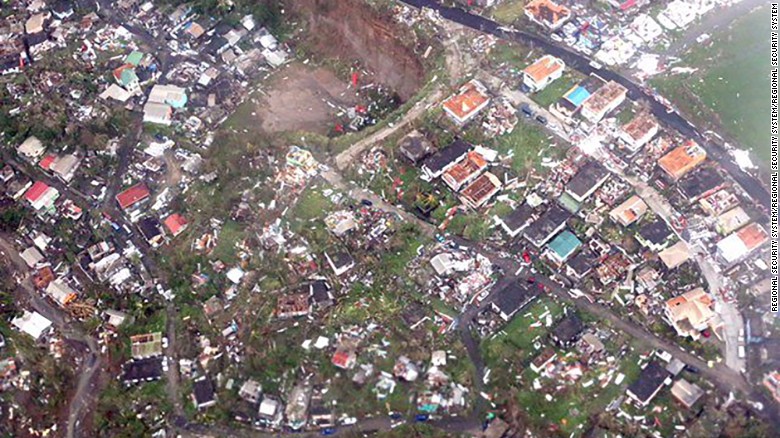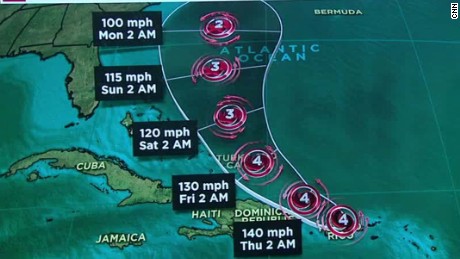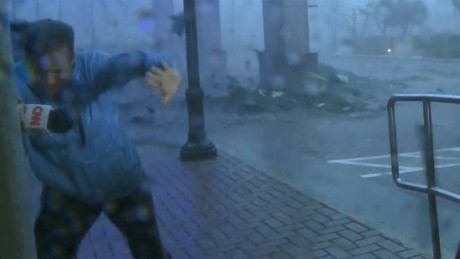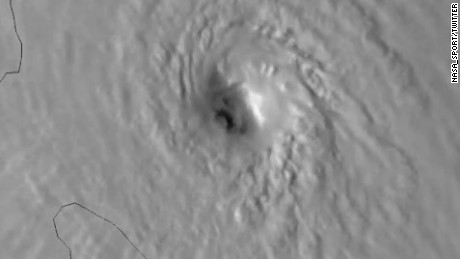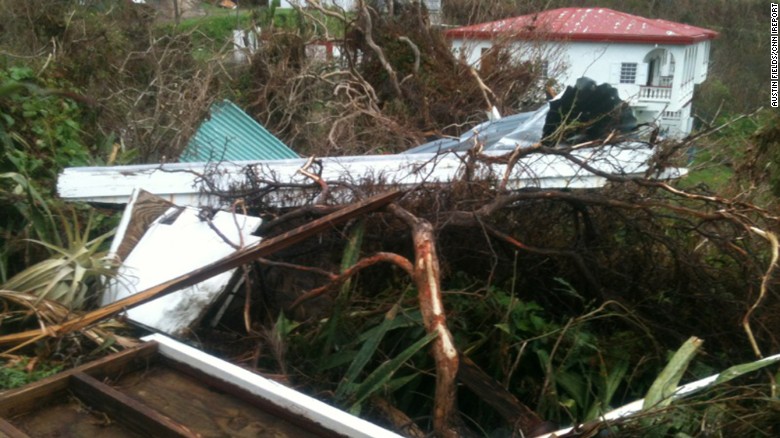SAN JUAN, Puerto Rico -- The strongest hurricane to hit Puerto Rico in over 80 years tore off roofs and doors, unleashed heavy flooding and brought down cell towers and power lines Wednesday in an onslaught that could deepen the island's financial crisis.
Leaving at least nine people dead in its wake across the Caribbean, Hurricane Maria blew ashore in the morning in the southeast coastal town of Yabucoa as a Category 4 storm with winds of 155 mph (250 kph), and was expected to punish the U.S. territory with life-threatening winds for 12 to 24 hours.
It was the second time in two weeks that Puerto Rico felt the wrath of a hurricane.

As people waited it out in shelters or took cover inside stairwells, bathrooms and closets, Maria slowly crossed the island, knocking down communication towers, snapping trees and unloading at least 20 inches (50 centimeters) of rain.
Widespread flooding was reported across the island, with dozens of cars half-submerged in some neighborhoods and many streets turned into rivers. People calling local radio stations reported that doors were being torn off their hinges and a water tank flew away.
About 90 percent of customers were without power.
The storm threatened to ravage the island's already crumbling electrical grid and worsen its economic woes.
PHOTOS: Devastation caused by Maria


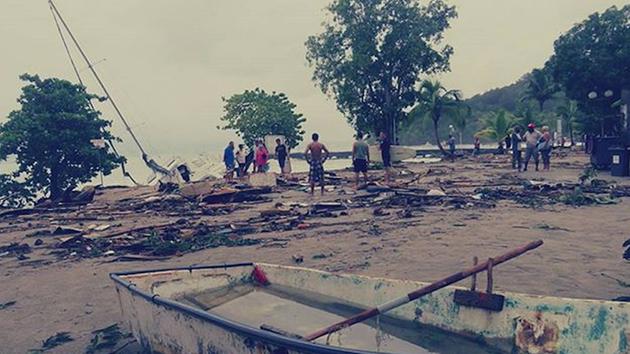

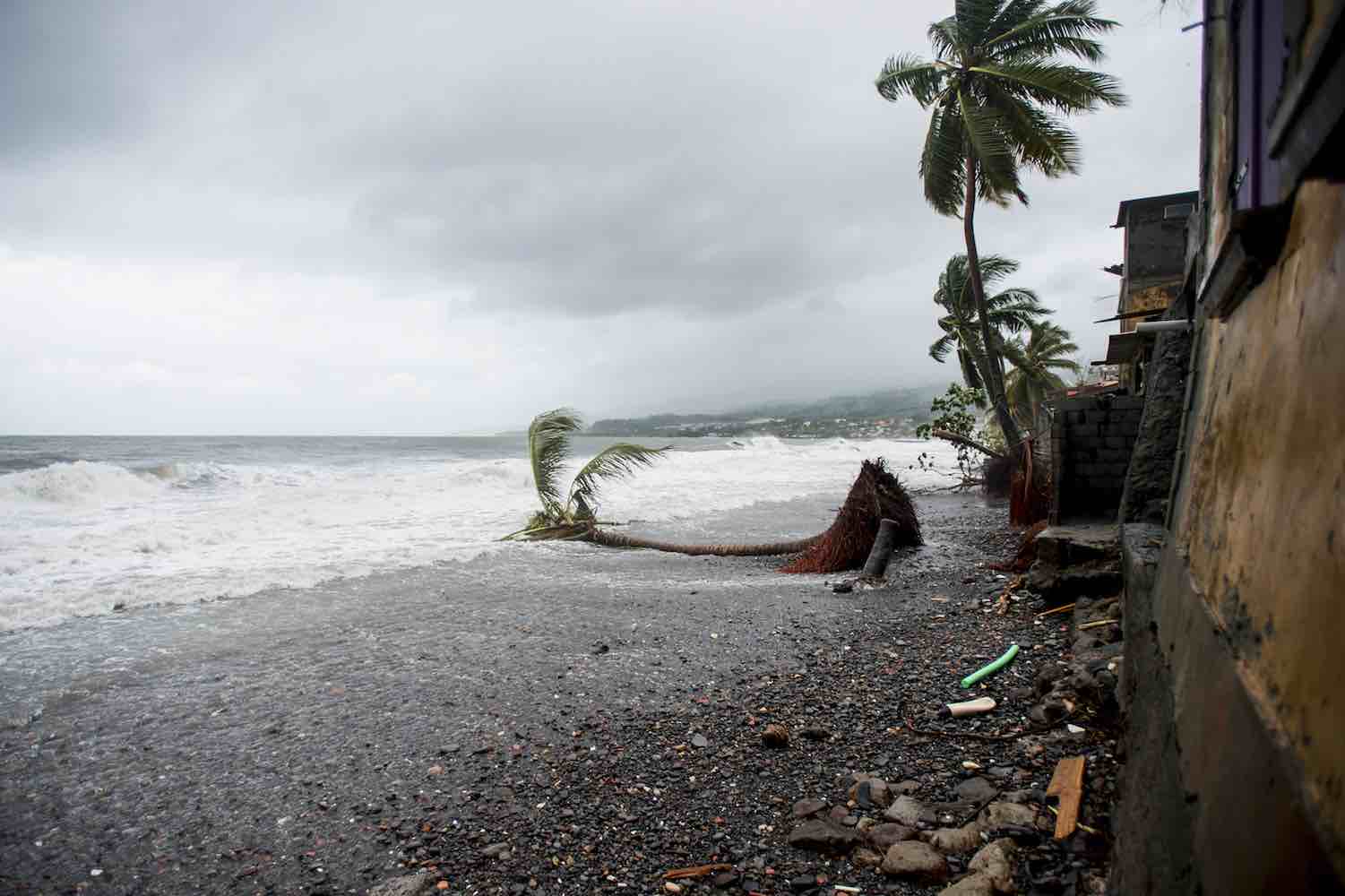

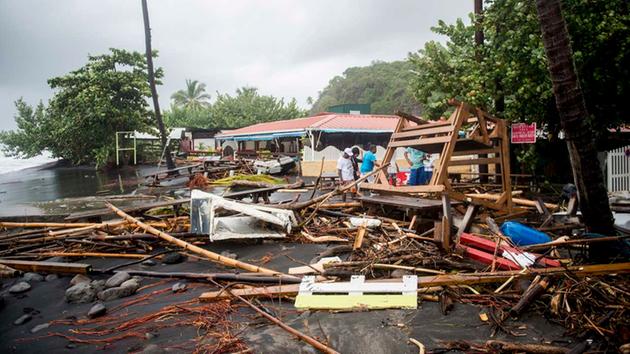
Puerto Rico is struggling to restructure a portion of its $73 billion debt, and the government has warned it is running out of money as it fights back against furloughs and other austerity measures imposed by a federal board overseeing the island's finances.
Gov. Ricardo Rossello urged people to have faith: "We are stronger than any hurricane. Together, we will rebuild."
He later asked President Donald Trump to declare the island a disaster zone, a step that would open the way to federal aid.
More than 11,000 people - and more than 580 pets - were in shelters, authorities said.
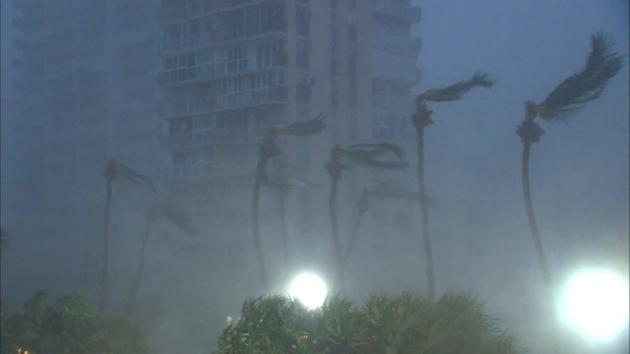
Felix Delgado, mayor of the city of Catano on the northern coast of Puerto Rico, told WAPA Television that 80 percent of the homes in a neighborhood known as Juana Matos were destroyed.
El Nuevo Dia newspaper reported that 80 percent of homes in a small fishing community near San Juan were damaged, and that an emergency medical station in the coastal town of Arecibo lost its roof, while communication was severed with several emergency management posts. A hospital and a police station reported broken windows, and a tree fell on an ambulance.
Those who sought shelter at a coliseum in San Juan were moved to the building's second and third floors, radio station WKAQ-AM reported.
Many feared extended power outages would further sink businesses struggling amid a recession that has lasted more than a decade.
"This is going to be a disaster," said Jean Robert Auguste, who owns two French restaurants and sought shelter at a San Juan hotel. "We haven't made any money this month."
THE LATEST FROM PUERTO RICO
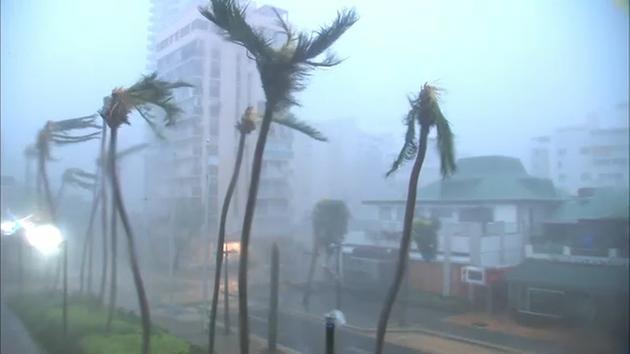
The heavy winds and rain and the noise of things crashing outside woke many across Puerto Rico before daybreak. At one recently built hotel in San Juan, water dripped through the ceiling of a sixth-floor room and seeped through the window.
"I didn't sleep at all," said Merike Mai, a vacationing 35-year-old flight attendant from Estonia.
As of late morning, the storm was centered about 25 miles (40 kilometers) west of San Juan with Category 4 winds of 140 mph (220 kph). It was moving to the northwest at 12 mph (19 kph).
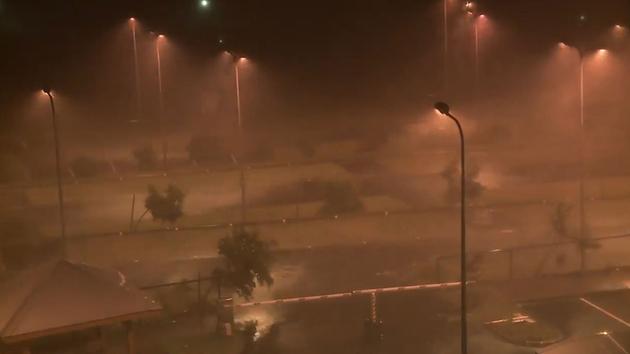
Early video from Tuesday shows Hurricane Maria's force on the island of Guadeloupe.
Previously a Category 5 with 175 mph (281 kph) winds, Maria hit Puerto Rico as the third-strongest storm to make landfall in the U.S., based on a key measurement that meteorologists use: air pressure. The lower the central pressure, the stronger a storm.
Maria's pressure was 917 millibars, lower than Hurricane Irma's 929 millibars when it roared into the Florida Keys earlier this month.
Irma sideswiped Puerto Rico on Sept. 6, causing no deaths or widespread damage on the island but leaving more than 1 million people without electricity. More than 70,000 still had no power as Maria approached.
Hurricanes tend to veer north or south of the island. The last Category 4 hurricane to blow ashore in Puerto Rico was in 1932, and the strongest ever to hit the island was San Felipe in 1928 with winds of 160 mph (250 kph).
As Maria closed in, Trump offered his support via Twitter: "Puerto Rico being hit hard by new monster Hurricane. Be careful, our hearts are with you - will be there to help!"
The storm's center passed near or over St. Croix overnight Tuesday, prompting U.S. Virgin Islands Gov. Kenneth Mapp to warn people to remain alert. St. Croix was largely spared the widespread damage caused by Irma on the chain's St. Thomas and St. John islands.
"For folks in their homes, I really recommend that you not be in any kind of sleepwear," Mapp said. "Make sure you have your shoes on. Make sure you have a jacket around." He added: "I don't really recommend you be sleeping from 11 o'clock to 4."
Maria killed two people in the French Caribbean island of Guadeloupe, and two people aboard a boat were reported missing off La Desirade island, officials said.
The storm also slammed the island of Dominica late Monday. Hartley Henry, an adviser to the prime minister, reported at least seven deaths and a "tremendous loss of housing and public buildings." He said the country was "in a daze," with no electricity and little to no communications.
"The situation is really grave," Consul General Barbara Dailey said in New York.
==============
San Juan, Puerto Rico (CNN)Hurricane Maria's eye has left Puerto Rico, but the mammoth storm is still lashing the island with devastating winds.
Maria weakened to a Category 3 hurricane Wednesday afternoon, hurling winds of 115 mph. But hurricane-force gusts topping 74 mph still extend over much of Puerto Rico, the National Hurricane Center said.
Maria's brute force wiped out electricity to the entire island. "We are 100% without power," a spokesman for the Puerto Rico governor's office said Wednesday.

Leaving at least nine people dead in its wake across the Caribbean, Hurricane Maria blew ashore in the morning in the southeast coastal town of Yabucoa as a Category 4 storm with winds of 155 mph (250 kph), and was expected to punish the U.S. territory with life-threatening winds for 12 to 24 hours.
It was the second time in two weeks that Puerto Rico felt the wrath of a hurricane.

As people waited it out in shelters or took cover inside stairwells, bathrooms and closets, Maria slowly crossed the island, knocking down communication towers, snapping trees and unloading at least 20 inches (50 centimeters) of rain.
Widespread flooding was reported across the island, with dozens of cars half-submerged in some neighborhoods and many streets turned into rivers. People calling local radio stations reported that doors were being torn off their hinges and a water tank flew away.
About 90 percent of customers were without power.
The storm threatened to ravage the island's already crumbling electrical grid and worsen its economic woes.
PHOTOS: Devastation caused by Maria







Puerto Rico is struggling to restructure a portion of its $73 billion debt, and the government has warned it is running out of money as it fights back against furloughs and other austerity measures imposed by a federal board overseeing the island's finances.
Gov. Ricardo Rossello urged people to have faith: "We are stronger than any hurricane. Together, we will rebuild."
He later asked President Donald Trump to declare the island a disaster zone, a step that would open the way to federal aid.
More than 11,000 people - and more than 580 pets - were in shelters, authorities said.

Felix Delgado, mayor of the city of Catano on the northern coast of Puerto Rico, told WAPA Television that 80 percent of the homes in a neighborhood known as Juana Matos were destroyed.
El Nuevo Dia newspaper reported that 80 percent of homes in a small fishing community near San Juan were damaged, and that an emergency medical station in the coastal town of Arecibo lost its roof, while communication was severed with several emergency management posts. A hospital and a police station reported broken windows, and a tree fell on an ambulance.
Those who sought shelter at a coliseum in San Juan were moved to the building's second and third floors, radio station WKAQ-AM reported.
Many feared extended power outages would further sink businesses struggling amid a recession that has lasted more than a decade.
"This is going to be a disaster," said Jean Robert Auguste, who owns two French restaurants and sought shelter at a San Juan hotel. "We haven't made any money this month."
THE LATEST FROM PUERTO RICO

The heavy winds and rain and the noise of things crashing outside woke many across Puerto Rico before daybreak. At one recently built hotel in San Juan, water dripped through the ceiling of a sixth-floor room and seeped through the window.
"I didn't sleep at all," said Merike Mai, a vacationing 35-year-old flight attendant from Estonia.
As of late morning, the storm was centered about 25 miles (40 kilometers) west of San Juan with Category 4 winds of 140 mph (220 kph). It was moving to the northwest at 12 mph (19 kph).

Early video from Tuesday shows Hurricane Maria's force on the island of Guadeloupe.
Previously a Category 5 with 175 mph (281 kph) winds, Maria hit Puerto Rico as the third-strongest storm to make landfall in the U.S., based on a key measurement that meteorologists use: air pressure. The lower the central pressure, the stronger a storm.
Maria's pressure was 917 millibars, lower than Hurricane Irma's 929 millibars when it roared into the Florida Keys earlier this month.
Irma sideswiped Puerto Rico on Sept. 6, causing no deaths or widespread damage on the island but leaving more than 1 million people without electricity. More than 70,000 still had no power as Maria approached.
Hurricanes tend to veer north or south of the island. The last Category 4 hurricane to blow ashore in Puerto Rico was in 1932, and the strongest ever to hit the island was San Felipe in 1928 with winds of 160 mph (250 kph).
As Maria closed in, Trump offered his support via Twitter: "Puerto Rico being hit hard by new monster Hurricane. Be careful, our hearts are with you - will be there to help!"
The storm's center passed near or over St. Croix overnight Tuesday, prompting U.S. Virgin Islands Gov. Kenneth Mapp to warn people to remain alert. St. Croix was largely spared the widespread damage caused by Irma on the chain's St. Thomas and St. John islands.
"For folks in their homes, I really recommend that you not be in any kind of sleepwear," Mapp said. "Make sure you have your shoes on. Make sure you have a jacket around." He added: "I don't really recommend you be sleeping from 11 o'clock to 4."
Maria killed two people in the French Caribbean island of Guadeloupe, and two people aboard a boat were reported missing off La Desirade island, officials said.
The storm also slammed the island of Dominica late Monday. Hartley Henry, an adviser to the prime minister, reported at least seven deaths and a "tremendous loss of housing and public buildings." He said the country was "in a daze," with no electricity and little to no communications.
"The situation is really grave," Consul General Barbara Dailey said in New York.
==============
San Juan, Puerto Rico (CNN)Hurricane Maria's eye has left Puerto Rico, but the mammoth storm is still lashing the island with devastating winds.
Maria weakened to a Category 3 hurricane Wednesday afternoon, hurling winds of 115 mph. But hurricane-force gusts topping 74 mph still extend over much of Puerto Rico, the National Hurricane Center said.
Maria's brute force wiped out electricity to the entire island. "We are 100% without power," a spokesman for the Puerto Rico governor's office said Wednesday.
The storm also ripped trees out of the ground and caused widespread flooding.
"This
is total devastation," said Carlos Mercader, a spokesman for Puerto
Rico's governor. "Puerto Rico, in terms of the infrastructure, will not
be the same. ... This is something of historic proportions."
Maria
has already killed seven people on the Caribbean island nation of
Dominica, said Gaston Browne, the Prime Minister of Antigua and Barbuda.
Browne said he had been communicating with the Prime Minister of
Dominica, Roosevelt Skerrit, who reported "widespread devastation" and
whose own house was shredded by the storm.
Maria
is expected to dump a total of 12 to 18 inches of rain on Puerto Rico
before barreling toward the Dominican Republic starting Wednesday night.
Puerto
Rican Olympic gymnast Tommy Ramos, who's riding out the storm in the
northern city of Vega Baja, posted video of gusts blowing debris in
front of him.
"The house is steady," Ramos told CNN. "What scares us is the flooding."
Holed up in the Puerto Rican capital of San Juan, Geffrard Dejoie said his hotel already was deluged by midmorning Wednesday.
"We are all sheltered in the
hallways, as a few windows in some rooms have broken," said Dejoie, a
traveling tennis coach. "We also are located very close to the lagoon,
and the water is coming up on the lobby, so we had to move to higher
floors."
Virgin Islands and Dominican Republic under the gun
Beyond
Puerto Rico, a hurricane warning was in effect for the British and US
Virgin Islands, Turks and Caicos Islands, the southeastern Bahamas and
the Dominican Republic from Cabo Engano to Puerto Plata, the hurricane
center said.
Dangerous storm surges
"accompanied by large and destructive waves" will raise water levels 10
to 15 feet above normal tide levels in the hurricane warning areas of
the southeastern Bahamas and the Turks and Caicos, the hurricane center
said.
And the British and US Virgin Islands could get pummeled with at least 5 to 10 inches of rain.
'First responders cannot go out there'
The hurricane slammed Puerto Rico with such intensity, it broke two National Weather Service radars on the island.
Calls for rescue immediately started pouring in -- but to no avail.
"First responders cannot go out there," Mercader said, echoing the governor's earlier warning that emergency crews wouldn't go outside in winds stronger than 50 mph.
Maria
was expected to cause widespread power outages across Puerto Rico.
Shortly after landfall, the storm had wiped out power in the east coast
city of Fajardo.
Maria became the first hurricane of Category 4 strength or higher in 85 years to hit the US territory, home to 3.3 million people.
Escaping the storm
Thousands
of Puerto Ricans heeded calls to go to emergency shelters. "As of 2:30
a.m. we count 10,059 refugees and 189 pets (in shelters)," the island's
governor, Ricardo Rosselló, tweeted.
After the storm made landfall, Rosselló asked US President Donald Trump to declare Puerto Rico a disaster zone, the governor tweeted. Which Trump did right away.
Tourists stranded
Some
tourists found themselves stranded on the island as flights, already
overbooked and increasingly expensive, became unavailable.
Heather
Farrell was on her honeymoon with her husband, Luke, after their
September 9 wedding. The couple had tried to cut the trip short but
couldn't.
"We
did try to get off, as early as Saturday, but all flights were either
booked or canceled," she said. "We actually are on the ocean -- our room
faces the ocean. It's pretty windy, but there is no rain. We'll stay
inside for now."
Hotel staff had asked all guests to head downstairs early Wednesday morning to take shelter in a safe room, Farrell said.
Nick
Bailey, Brandon Edwards and John Michael Berndt -- three friends from
northern California -- chose this week to vacation on the island. They
were aware of Maria, which was only a tropical depression when they left
California.
"Our
hostel is taking good care of us," Berndt said, adding that staff there
had boarded all the windows and created a concrete hurricane barrier.
"This is a good area, apparently," Bailey said. "It's close to hospitals and emergency centers."
The men also were moved to rooms deeper inside the hostel -- without any windows.
Prime Minister's house destroyed
As
Maria pushed through the Caribbean toward Puerto Rico, two people were
missing after a boat sank off the coast of La Désirade, a small island
near the mainland of Guadeloupe. About 80,000 people, or 40% of
households on the island, were left without power, the government said.
The
storm also caused "widespread devastation" in Dominica, the country's
Prime Minister said Tuesday. Maria ripped off the roof of his own house
and left much of the island -- population 73,000 -- in ruins.
